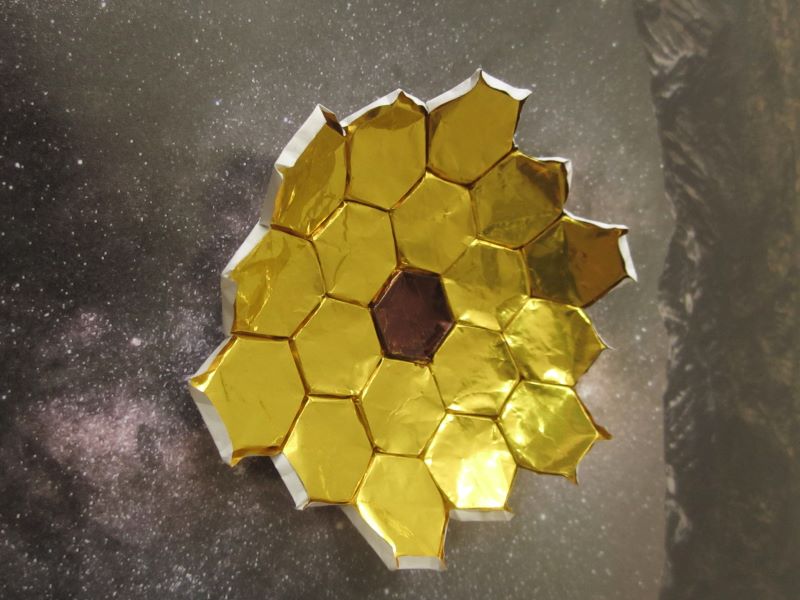Last month I heard a lot of buzz about the James Webb Space Telescope. So I made origami of it.

James Webb Telescope, designed by Robert J. Lang. Folding template online.
Specifically, this is just the big mirror component of the James Webb Space Telescope (JWST).
Since people are currently interested in the JWST, and since I just made origami of it, and since I have a physics background, I thought I’d talk about it. Or at least, explain why the mirrors look that way.
The James Webb Space Telescope Mirrors
The JWST is an infrared telescope recently deployed about 1.5 million kilometers from Earth. My understanding is that the infrared light range is interesting because it allows us to see very distant galaxies that have been redshifted into the infrared range.
One of the challenges in astronomy is that many objects are very dim, and you need sensitive instruments to get good reads. To get a brighter image, you need to collect more light. To collect more light, you need a bigger telescope.
A common mistake is to think that by making a bigger mirror, you can see a wider angle–effectively increasing your peripheral vision. But it’s just like the human eye. When you’re in a dark room, your pupils dilate–which doesn’t increase your peripheral vision, it just collects more light so that you can see better in the dark.
The JWST has the largest mirror to be deployed in space–6.5 meters across, compared to the Hubble Space Telescope’s 2.4 meter mirror. This comes with a few challenges, like how the mirror doesn’t actually fit into the rocket used to deliver the telescope into space. To fit in the rocket, the mirror folds. Uh, it’s not really much like origami if we’re being honest, it’s just 3 of the hexagons on each side fold back.
Why is the mirror composed of 18 hexagons, when only three separate mirror pieces would suffice? To be honest, I don’t really know, and there are larger single mirrors deployed on Earth. But the symmetry of the design makes things simpler. And I suspect that having lots of smaller mirrors is good because each mirror can individually be adjusted to greater precision.
As for why the mirrors have a golden color, that’s because they’re literally coated in gold. Obviously, as mirrors, you want them to reflect light well. But the coating was chosen to optimize for infrared light, not visible light, so there are some visible light colors that don’t get reflected very well, and that gives it its golden color.
To learn more, I also recommend NASA’s page on the mirrors.
JWST Origami
As a consequence of JWST’s folding mirror design, there are a lot of articles saying that it folds just like origami. I think that’s kind of exaggerating the connection, but nonetheless. NASA asked Robert Lang–world famous origamist and physicist–to make an origami design.
Now I look at this design and I think, that looks like Origamizer. Origamizer is an algorithm that can create folding patterns for any polyhedron. Now I’m not saying this was definitely made by Origamizer, but it’s at least following similar principles. The origami design is made of flat hexagons (in contrast to the real JWST mirrors, which have curvature), which are connected by little pleat folds to give it its overall shape.
I initially tried just printing out the design, but I don’t like working with printer paper. So I took a print-out, and transferred the design over to some traditional origami paper by careful scoring. I creased along each individual line, and then collapsed it. This is probably fairly difficult if you don’t have experience with the crease & collapse paradigm of origami, but to me this is fairly standard.

I believe it was the heat shield that was the real piece of origami.
@DataWrangler,
I think you’re right. I didn’t know about that because I didn’t read about the heat shield.
Infrared is also useful when hunting objects that are cooler than stars, eg. exoplanets.
Solid gold is used in space, because it has high surface tension, which makes it resistant to plasma erosion.
Yes, this design is much like what could be produced by Origamizer, in that there are edge gadgets and vertex gadgets; but in this case, the gadgets were carefully (manually) designed to do two things.
(a) Keep a nearly constant amount of material between the panels (Origamizer would optimize away much of the paper in the gaps).
(b) Avoid lateral offsets between panels that would make some edge gadgets have sliver-like gussets (and would substantially complicate the vertex gadgets).
As with the JWST panels, they’re not perfect equilateral hexagons, so as to result in a paraboloidal shape. (And it differs from JWST in that paper version has planar panels, rather than paraboloidal panels, of course).
When you start looking closely, various origami algorithms start to blur together (they all rely on the same underlying math). So yes, this could be viewed as a special case of Origamizer, with the added constraints mentioned above. Or it could be viewed as a special case of TreeMaker, applied to the region between the panels (“bring mating edges together to be collinear”). Perhaps closest, though, is it’s a special case of a honeycomb design created manually years ago as part of a display of origami bees.
@bugfolder,
Thanks for the detail!
It’s a very clean design, and even though I didn’t really get the vertex gadgets quite as neat as the crease pattern, it seemed quite tolerant of the error.
Gotta love gilded origami. Very American. You can tell I’ve been watching The Gilded Age on HBO.
@Mara Jade,
That foil paper can be pretty difficult to work with! I always warn beginners away from it. But I have so much that I’ve had time to get a lot of experience with it.